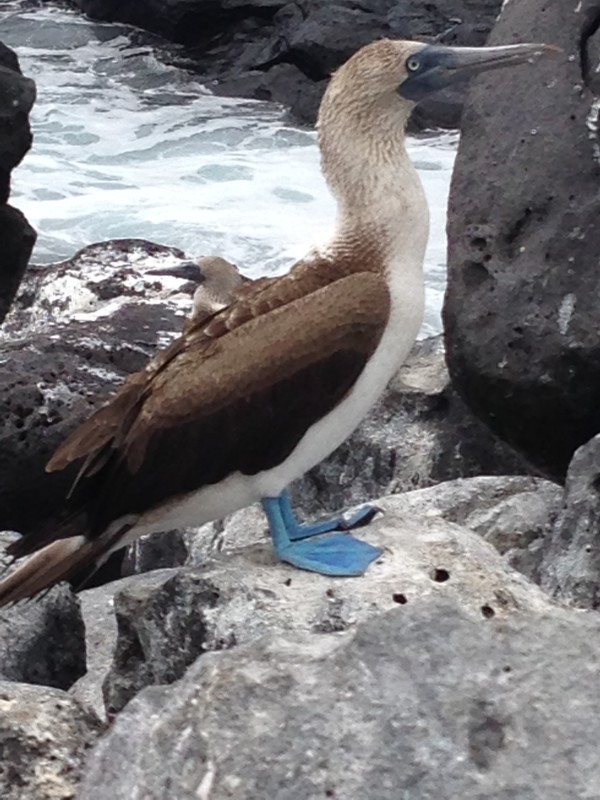The Galapagos islands. Fodder for Darwin’s theory of natural selection, home to sea lions and iguanas so “tame” you can nearly shake hands, and the dream destination for wildlife-watchers who seek its famous specialized finches and the Blue-footed Booby. Add to the list: Bobolink.
The Galapagos is packed with endemic species – found nowhere else in the world. Over 1,000 km from Ecuador’s mainland, the collection of islands hardly makes for a convenient stop for migratory songbirds. Aside from long-distance migratory shorebirds and pelagic wanderers, only the occasional straggler might be found here. But Bobolinks have been recorded in the Galapagos regularly, as far back as Darwin’s famous expedition, when he “collected” one for documentation.
An exception to most songbirds in a variety of ways, the Bobolink breaks the mold in that it is a migratory songbird that stops in the Galapagos each year. Regular visits by a few individuals have earned the Bobolink suspect status in the transmission of a blood parasite. Found to infect endemic birds like the Galapagos penguin, but not of Galapagos origin, the parasite was presumed to be brought in. It is transmitted through mosquitos.
VCE and collaborators have been collecting Bobolink blood from across the breeding range for a study led by Dr. Patricia Parker at Mississippi State University. It turns out many Bobolinks carry 2 of the 4 lineages of the parasite found in Galapagos birds. Our mission was to demonstrate that the few dozen Bobolinks that visit the Galapagos each year are carrying the parasite.
We stepped off the boat after a jarring two-hour ride, happily greeting San Cristobal, the island with most of the scattered Galapagos records of Bobolinks. Noah Perlut (University of New England) spent months obtaining the proper permits, and along with volunteer Jennifer Megyesi, we had 12 days to search the San Cristobal’s 195 square miles for a needle in a haystack. We guessed when the Bobolinks would be coming through, based on historical records and geolocator data from the typical southbound migratory route through Venezuela and Colombia.
There were doubters. Our colleagues congratulated us on finding an excuse to visit the Galapagos, convinced we would not produce a Bobolink, much less figure out a way to catch any in order to collect blood samples. We approached the challenge with measured optimism.
Bobolinks prefer grasslands throughout the year, and fortunately for us, there are only a few on the island. Our first day out, our trusty driver Moises (taxis are the only option for getting around) knew the roads and many of the landowners, and within a few hours we were stepping out at any open grassland we saw to look and listen…but nothing. It was rainy up in the “highlands” of the island at 500m, and we found out that a nice day there is the exception. On our way back home, we passed a grassland owned by a friend of the driver’s, and he suggested it. We had focused on where there was seed available, the main diet item of Bobolinks during the non-breeding season. This pasture didn’t look like it had tons of seed, but unlike the other grasslands we had seen, it had not been grazed for the past 3-4 years, and had a carpet of dead grass beneath and taller green grass above.
We had already become accustomed to the small ground-finch, which is smaller and has a different flight pattern than Bobolink. Two of us saw something that looked different, and then we all heard it – the characteristic “check” call. Two Bobolinks popped up right before us. Once the high-fives were taken care of, we wasted no time.
Out came the nets, poles, and Bobolink recordings to attract the birds. We had no idea how they would respond. Though it was beginning to spit precipitation, the birds went for it, and within 10 minutes we had one in the net. We collected the usual measurements, and some blood to be tested for the parasite, took a few photos, and the Bobolink was returned to its business. In the days following, we were not to have such instant luck again, but we caught 8 more Bobolinks. Some were emaciated and probably just arrived to the island after their long flight, and others had substantial fat. We only counted up to 10 Bobolinks on a given day between the two (disparate) sites where we found them. We saw at least a couple of our banded birds hanging around days after being banded.
As far as we know, we are second only to Darwin to have a Bobolink in the hand in the Galapagos, and first to hold a live one. Results from the lab will tell us whether they are connected to the Galapagos endemics by more than geography.



how cool is this….. my favorite bird in vermont, males dont fly they float, they dont sing they sound like r2d2, always flirting with the exceptional, here again
Roz – this is so exciting. You have to wonder when these flights began (were the islands ever closer to the mainland?) and why these birds would put themselves at such risk to get all the way to the Galapagos. Fascinating.
Thanks for the great post.